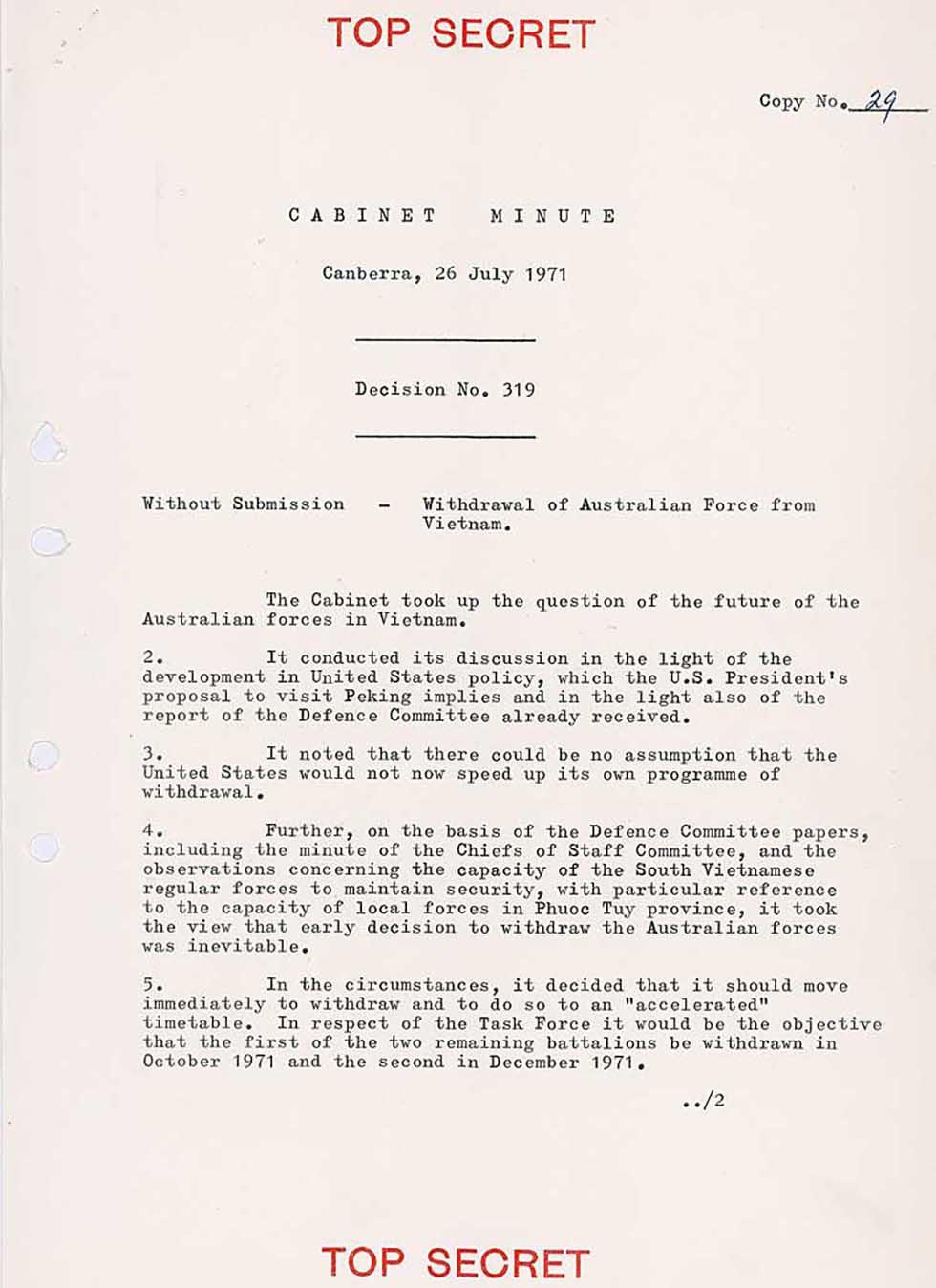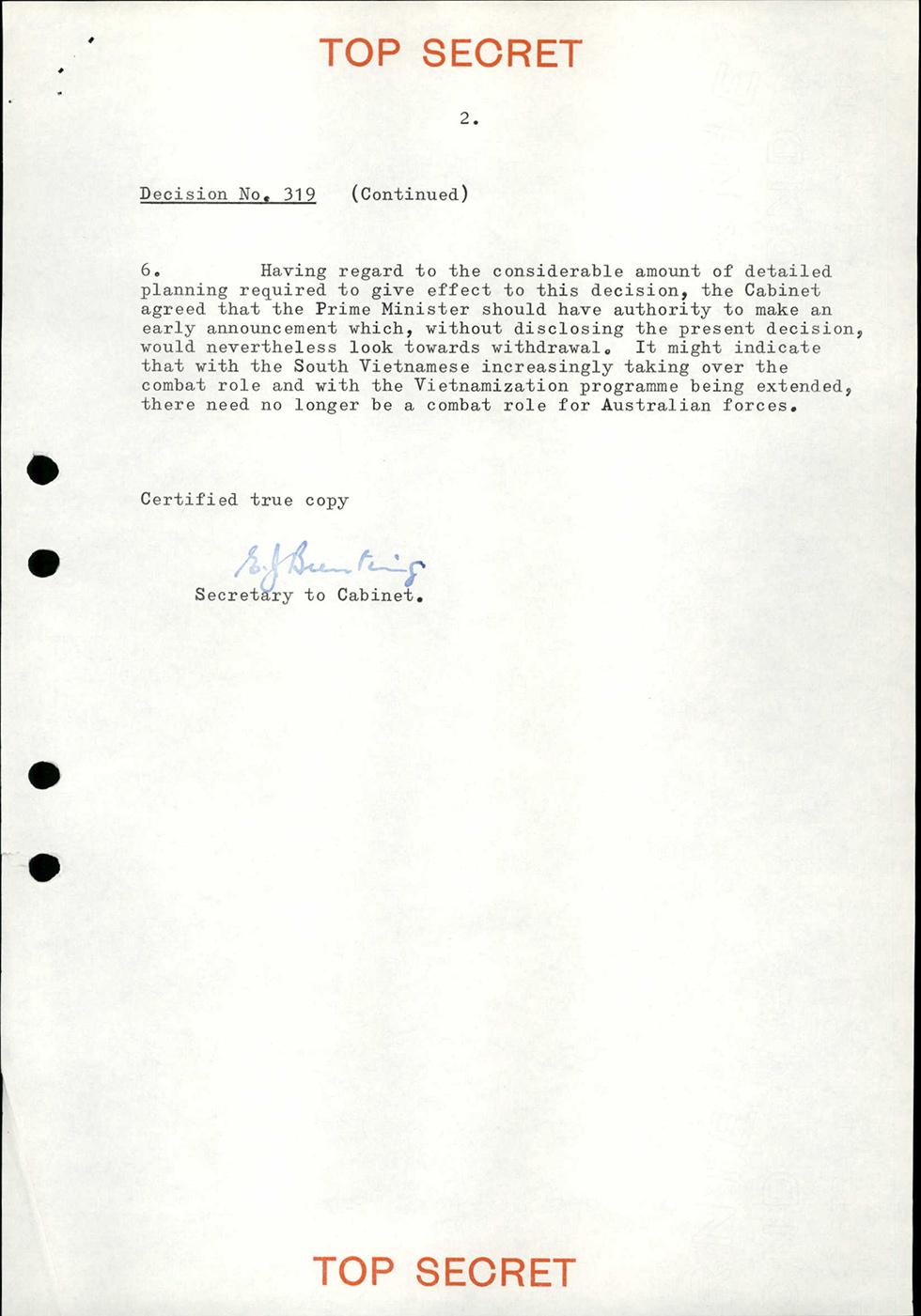

Aboriginal and Torres Strait Islander people should be aware that the National Archives' website and collection contain the names, images and voices of people who have died.
Some records include terms and views that are not appropriate today. They reflect the period in which they were created and are not the views of the National Archives.



[Page 1]
[Header and footer in large red letters:] TOP SECRET
Copy No. 29
CABINET MINUTE
Canberra, 26 July 1971
[Dividing line.]
Decision No. 319
[Dividing line.]
[Heading:] Without Submission – Withdrawal of Australian Force from Vietnam.
The Cabinet took up the question of the future of the Australian forces in Vietnam.
2. It conducted its discussion in the light of the development in United States policy, which the U.S. President's proposal to visit Peking implies and in the light also of the report of the Defence Committee already received.
3. It noted that there could be no assumption that the United States would not now speed up its own programme of withdrawal.
4. Further, on the basis of the Defence Committee papers, including the minute of the Chiefs of Staff Committee, and the observations concerning the capacity of the South Vietnamese regular forces to maintain security, with particular reference to the capacity of local forces in Phuoc Tuy province, it took the view that early decision to withdraw the Australian forces was inevitable.
5. In the circumstances, it decided that it should move immediately to withdraw and to do so to an "accelerated" timetable. In respect of the Task Force it would be the objective that the first of the two remaining battalions be withdrawn in October 1971 and the second in December 1971.
../2
[Page 2.]
[Header and footer in large red letters:] TOP SECRET
[Page number] 2.
[Underlined heading:] Decision No. 319 (Continued)
6. Having regard to the considerable amount of detailed planning required to give effect to this decision, the Cabinet agreed that the Prime Minister should have authority to make an early announcement which, without disclosing the present decision, would nevertheless look towards withdrawal. It might indicate that with the South Vietnamese increasingly taking over the combat role and with the Vietnamization programme being extended, there need no longer be a combat role for Australian forces.
Certified true copy
[Handwritten signature:] E.J. Bunting
Secretary to Cabinet.
This is the record of a top-secret federal Cabinet decision on 26 July 1971 to withdraw Australian forces from Vietnam. It noted a proposed visit by President Richard Nixon to Peking (Beijing). This signalled a development in US policy—because at that time, neither the United States nor Australia had officially recognised communist China, an ally of North Vietnam.
Cabinet considered that the United States might now speed up its own troop-withdrawal program. Cabinet accordingly decided to withdraw Australian troops on an accelerated timetable. It authorised Prime Minister William ‘Billy’ McMahon to make an early announcement that ‘looked towards’ withdrawal, but not to disclose the Cabinet decision.
This document marks a major change—from participation to disengagement—in Australian Government policy about the Vietnam War. From 1962 to 1975, more than 60,000 Australians served in Vietnam as part of a US-led allied force. Australia’s involvement supported South Vietnamese government forces against the Vietcong, a communist-led insurgent force supported by the North Vietnamese Army. Almost 2400 Australians were wounded and 520 Australians died.
This record provides evidence of how Australia's involvement in the Vietnam War was closely linked to the policies of the United States and broadly followed changes in those policies. When the United States committed combat troops in March 1965, Australia followed, and when the United States boosted troop numbers in 1966, so did Australia. Similarly, after the United States began to withdraw troops in 1969, Australia began pulling out in 1970.
Nixon's decision to visit Beijing was an embarrassment for Prime Minister McMahon. McMahon had only that month denounced opposition leader Gough Whitlam for making such a visit, calling him a spokesman for the enemy in Vietnam.
The immediate effect in Australia of Nixon's proposed visit was the realisation that changes in US policy towards South Vietnam would undoubtedly occur. The record reveals that Cabinet made a direct link between the visit and the possibility of a further US troop withdrawal from Vietnam. It was important not to be too far ahead or behind US policy announcements, so the Prime Minister was given discretion as to the timing of Australia's own announcement.
Cabinet took particular note of reports on the capacity of South Vietnamese regular forces to maintain security in Phuoc Tuy Province. Since May 1966, most Australian military personnel in South Vietnam had been based in this province as part of 1 Australian Task Force (1ATF). By July 1971, 1ATF was largely involved in 'pacification' operations in Phuoc Tuy, as South Vietnamese forces took more security responsibility.
The decision to withdraw Australian troops was made in July 1971 and a withdrawal timetable of October and December 1971 was established. However, Australian hostilities in Vietnam did not formally cease until January 1973 when the United States, North Vietnam, South Vietnam and the Vietcong signed a peace agreement in Paris. The Australian Embassy Guard Platoon Saigon remained in Vietnam until July 1973.
Learning resource text © Education Services Australia Limited and the National Archives of Australia 2010.
Learn how to interpret primary sources, use our collection and more.
